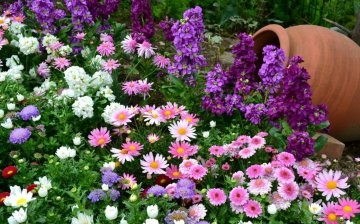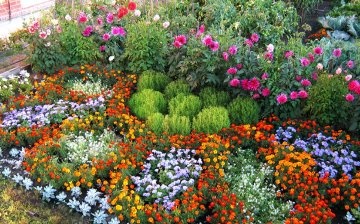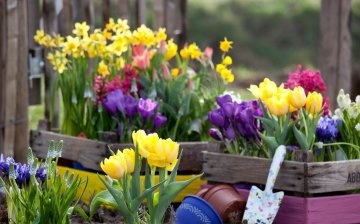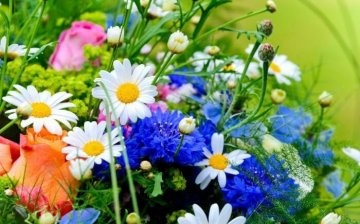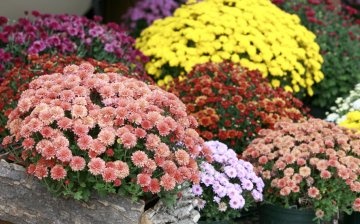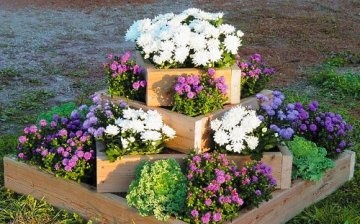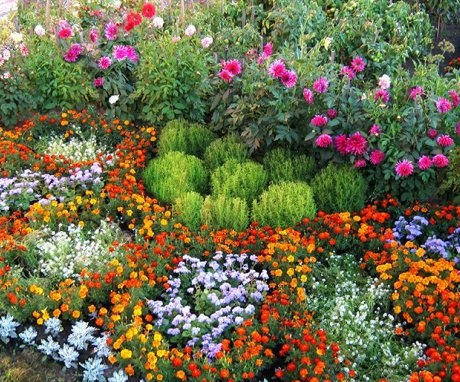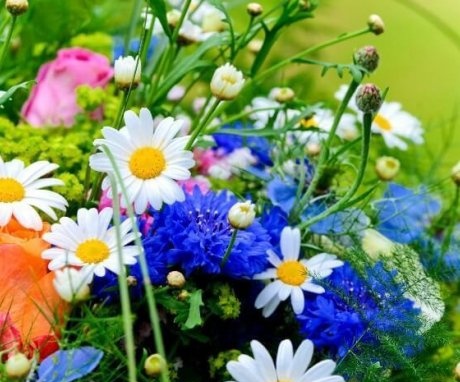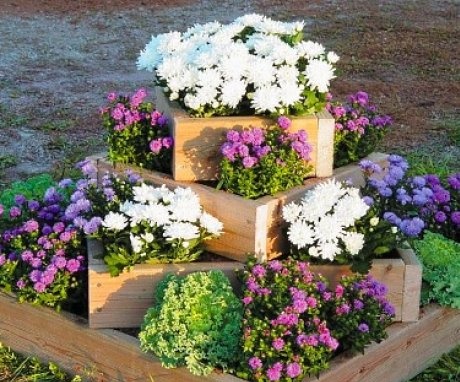Continuous flowering flower bed: types of seasonal flowers and tips for decorating a flower bed
The beauty corner helps you relax and enjoy the scent of luxurious flowers. Flower bed continuous flowering allows you to admire the beauty of the plants throughout the season. She pleases with bright colors, delicate aroma, with her help the gardener can reveal the artistic nature. To create a corner for the soul, you need to know some basic rules for growing flowers, take into account many nuances. This guide to creating flower beds will help the gardener determine the shape of the future plot with flowers, plant species and original design options for a flower garden.
Content:
- General rules for decorating a flower garden
- Choosing flowers for spring
- Choosing flowers for summer
- Choosing flowers for autumn
- Design solutions for decorating flower beds
General rules for decorating a flower garden
Any flower bed is created depending on the general idea of the gardener. Whether he wants to organize a wild corner with field herbs and flowers or arrange a flower bed of continuous flowering. The latter is considered the dream of every land owner. Its creation requires knowledge of general rules and features.
A flowerbed of continuous flowering is created on the basis of perennials and annuals of different varieties and species. The first step is the term flowering, color and size of the plant. Depending on this, the site is delimited.
The area allocated for a flower bed is divided so that the tallest plant species are in the background, and the stunted ones are in the foreground.
The factor of human perception of the flower bed is taken into account. What it is? The fact is that if the flower garden breaks up near its point of view, then the background plants should not be too tall and bulky, otherwise the overall impression will inevitably deteriorate. It is necessary to organize the flower bed so that tall shrubs are half the size of the distance between the flower garden and its place of observation.
Ornamental shrubs must be planted in a flowerbed of continuous flowering - host, barberry or spirea... This unspoken rule is well founded. Shrubs cover the gaps, fill the space and emphasize the brightness of the flowers. They are planted in the background of a flower bed. It is better to organize the planting of plants with the so-called "bumps". That is, each type of flowers is planted in a bunch, and not stretched along the line. This way of organizing looks impressive. Moreover, it is possible to accommodate more types of flowers than in the standard design - in a line.
Choosing flowers for spring
From April or May, you can already enjoy the first flowering of early, spring flowers. They open the season of continuous flowering of the flower bed. These types of plants, as a rule, do not bloom for long. Therefore, you should choose those varieties that will delight the eye as long as possible.
In the spring, it is preferable to plant bulbous plants. They are divided into those that bloom from under the snow and those that delight in April or early May. These include:
The beauty of the flowering of these plants can be admired at the first thaw.Further on the flowerbed, flowers of later vegetation periods will delight:
Thus, in April and May, as well as in early June, it will be possible to contemplate the luxurious beauty of early and late blooming plants. It is important to organize the clumps of flowers so that you get a cascade of systematically blossoming buds of different types. Try to choose bright and rich colors. Plant several varieties of tulips. When choosing spring flowers, immediately determine the general mood of the flower bed. For example, you want to admire the delicate shades of pink and white or yellow and white. Depending on this, decide on the color of the flowers.
Caring for plants of early flowering period consists in timely pruning of faded inflorescences.
Watering usually not as important as the ground is still filled with melt water. Desirable feed flowers with mineral complexes, apply fertilizers containing nitrogen compounds. So the flowers will quickly wake up from hibernation.
As the plants wither, the gardener should remove dry leaves and stems, cut off withered inflorescences so that the flowering of other "neighbors" is not lost against the background of already faded flowers. If bald spots form after the growing season, they can be covered with any decorative element - a garden statue or decorative flowerpot, stone.
Choosing flowers for summer
The principle of selection of summer perennials or annuals is also based on flowering times and sizes. Some plants start to delight in June, others bloom only in the second half of July or in August. Therefore, always consider this point when planting summer flowers.
Summer flowers are selected depending on color, size and flowering time. Usually these are perennials mixed with annuals. This group of flowers is subdivided into those that bloom from the end of June to the whole of July. Some can bloom throughout August. The summer group includes:
The flowering of these luxurious and fragrant plants is replaced by later annuals. Some can bloom until late autumn. This group includes:
All these flowers will delight all summer. Their correct organization will allow the gardener to enjoy luxurious flowering and inhale the wonderful scent of summer flowers. In the summer, unlike in the spring, it is necessary to constantly care for the flower bed of continuous flowering. Flowers must be watered and monitored for their health. In flower beds, due to the frequent planting of different types of plants, pests and illness... Therefore, carefully examine the plants, try to weed out weeds, if possible. Monitor soil moisture. If the season is rainy, be sure to check the base of the plants for a slug.
Throughout the season, bring in fertilizers, flowers are very responsive to feeding, they instantly react with abundant flowering and juicy greens.
Try to plant flowers according to the growing conditions of each species. For example, plants that love shade can be planted near shrubs. They will cast a shadow on the flowers. Plant those that love the sun and warmth in an open area of the flower bed. Taking into account all the nuances and caring for summer flowers, the flower bed will constantly be drowned in bright colors and a wonderful aroma.
Choosing flowers for autumn
When summer comes to the end it is very sad to watch withered greenery of summer flowers. However, there is a way out - it's time for the autumn beauties. There are not so many species to this group of flowers, but these few plants will instantly cheer up and brighten up uncomfortable, cloudy autumn days.
The group includes:
- Chrysanthemum
- Aster
- Fat woman
- Colchicum
These bright and juicy beauties of autumn will transform the garden.They bloom until the first cold weather and decorate a flowerbed of continuous flowering with dignity. Shrubs come to their aid, the foliage of which is painted in a pleasant ocher or fiery burgundy color. For the period from August to October, you can plant not only plants of the autumn flowering period, but also ordinary herbs. In the fall, they acquire a very spectacular appearance. In the fall, they usually begin "general" cleaning of the flower garden. All dried and withered leaves, stems, flowers are collected.
Autumn flowers are watered and fed, but rarely.
It usually rains in August and autumn. therefore watering exercise moderate as the soil dries. Late plants do not require special, scrupulous care. The main thing is to remove the withered years from the flower bed, to give them space for growth.
If bald spots have formed during cleaning, cover them with decorative elements - flowerpots or garden figurines. When cold weather comes, cover up those plant species that need it. It is advisable to cover the flower bed with a layer sawdust mulch or compost for the winter. The measure will preserve moisture and prevent plants from freezing in winter.
Design solutions for decorating flower beds
It is not at all necessary to break the flower garden in a standard shape in the form of a square or rectangle. Now it is very fashionable to organize a flower garden with triangles that form a star shape. It looks very nice and impressive. Attach the flowerbed to the wall so that a semicircle forms. Round flower beds always look profitable and successful. They are easy to care for, as the plants are easily approached from all sides.
You can organize a cascading flower bed:
- The so-called ladders are built, that is, an upward climb is obtained.
- In each row, plants "live", divided according to their seasonal flowering.
- Tall shrubs are planted on the sides of such a structure, junipers, barberries and other ornamental plants.
If the site is small, you can organize a flower bed consisting only of flowers without tall shrubs. The design of the flower garden depends on the size of the site, the wishes of the owner and the region.
Breaking a flower bed of continuous flowering is a very interesting activity!
The grower himself plans the flower bed and grows the flowers. From experience, he already understands what is needed specifically for the site, what is in harmony with the house and what types of plants characterize the nature of the gardener himself. Consider the general rules for decorating a flower bed and everything will work out!
More information can be found in the video.



